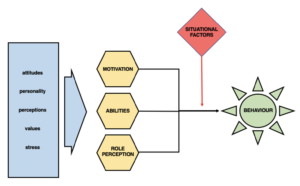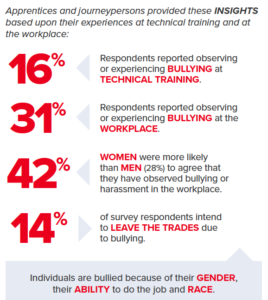Effective Communication Practices
Workplace Responsibilities
Personal Responsibility
“Weakness of attitude becomes weakness of character.” – A. Einstein
Attitude when applied to humans, is best described as, “mental position with regard to a fact or state a helpful attitude; a feeling or emotion toward a fact or state a negative attitude an optimistic attitude.” In essence, it is a settled way of thinking or feeling about someone or something, typically where that is reflected in a person’s behavior.
With regard to the MARS model of behaviour shown below, attitudes play a key role in influencing behaviours.

Several factors drive, or fuel, our sense of motivation, our ability to perform a task, and how we view ourselves within a specific task or group. In turn, these join together and manifest themselves in our behaviour. You’ll notice that outside influences will affect our motivation, ability, or our perceptions, but only after we have set in motion those attributes with ourselves. This is why, despite our situation or environment, we can for the most part choose our attitude towards a particular event or person or group.
How Are Attitudes Formed?[1]
There is considerable disagreement about this question. One view offered by psychologist Barry Staw and others is the dispositional approach, which argues that attitudes represent relatively stable predispositions to respond to people or situations around them. That is, attitudes are viewed almost as personality traits.
Thus, some people would have a tendency—a predisposition—to be happy on the job, almost regardless of the nature of the work itself. Others may have an internal tendency to be unhappy, again almost regardless of the actual nature of the work. Evidence in support of this approach can be found in a series of studies that found that attitudes change very little among people before and after they make a job change. To the extent that these findings are correct, managers may have little influence over improving job attitudes short of trying to select and hire only those with appropriate dispositions.
A second approach to attitude formation is called the situational approach. This approach argues that attitudes emerge as a result of the uniqueness of a given situation. They are situationally determined and can vary in response to changing work conditions. Thus, as a result of experiences at work (a boring or unrewarding job, a bad supervisor, etc.), people react by developing appropriate attitudes.
Several variations on this approach can be identified. Some researchers suggest that attitudes result largely from the nature of the job experience itself. That is, an employee might reason: “I don’t get along well with my supervisor; therefore, I become dissatisfied with my job.” To the extent that this accurately describes how attitudes are formed, it also implies that attitudes can be changed relatively easily.
For example, if employees are dissatisfied with their job because of conflicts with supervisors, either changing supervisors or changing the supervisors’ behavior may be viable means of improving employee job attitudes. In other words, if attitudes are largely a function of the situation, then attitudes can be changed by altering the situation.
Attitudes are often informed by what we think and what we value. Attitudes are often reflected in our emotions and feelings. These emotions and feelings will drive our motivations and have a direct effect on our perceptions of where we fit within a particular situation or group of people. Therefore, it is important to remember a few key points about the relationship of our attitude to our personal work responsibilities;
- The only person responsible for our attitudes, emotions, and feelings is ourselves.
- Due to the powerful nature of our attitude, we must remember that attitude informs behaviour, not vice versa.
- In most circumstances, our level of performance – both in our work and with others, is a reflection of our attitudes. If we carry a low or poor attitude towards a task or a person, then our interactions within the task or with the person will be correspondingly low.
The relationship between our attitudes and our behaviour can also manifest itself in the form of harassment and discrimination.
Harassment often linked with the act of Bullying, as defined by WorkSafe BC is:
“Bullying and harassment in the workplace can take many forms, including verbal aggression, personal attacks, and other intimidating or humiliating behaviours.”
Further, a person is bullied and harassed when someone takes an action that he or she knew or reasonably ought to have known would cause that worker to be humiliated or intimidated.
Examples of behaviour or comments that might constitute bullying and harassment include verbal aggression or insults, calling someone derogatory names, harmful hazing or initiation practices, vandalizing personal belongings, and spreading malicious rumors.
WorkSafe BC video about harassment and job place bullying.
If workplace bullying and harassment are not addressed, it can lead to lost productivity, anxiety, depression, and injuries at work.
Discrimination, defined by the province of British Columbia is:
Inappropriate workplace behaviour conduct or comments that can be perceived to be belittling or condescending.
All employees have the right to work without discrimination. The prohibited grounds of discrimination in the BC Human Rights Code include:
“race, colour, ancestry, place of origin, religion, family status, marital status, physical disability, mental disability, sex, age, sexual orientation, political belief or conviction of a criminal or summary conviction offense unrelated to their employment.”
As is illustrated, harassment and discrimination can take many forms. Engaging in any of these behaviours is patently wrong and must be addressed and corrected. As is suggested in the video, the ripple effect of someone’s harassment, bullying, and/or discrimination is large and powerful. The following information from the Canadian Apprenticeship Forum paints a clear picture of the reality of this important issue.

Many employers have policies and procedures for dealing with this destructive behaviour. The role of the human resource coordinator or department can help both the employee and the employer address issues such as these in the workplace. Many times, attitudes can be changed through awareness training, workshops, and toolbox meetings which specifically address the issue without singling out individuals. This has proven to make a marked difference in harassment and discrimination on the job site.
The need for this kind of training, awareness, and practice could not be emphasized enough. The skilled trades are losing too many qualified people. Be sure to check below for some links that will offer information and help for all parties.
Key Takeaways
BC Human Rites Code
http://www.bclaws.ca/EPLibraries/bclaws_new/document/ID/freeside/00_96210_01
WorkSafe BC information for employees – https://www.worksafebc.com/en/health-safety/hazards-exposures/bullying-harassment
WorkSafe BC information for employers – https://www.workbc.ca/Employer-Resources/Your-Workforce/Workplace-Rights.aspx
[1] Organizational Behavior – Download for free at https://openstax.org/details/books/organizational-behavior

